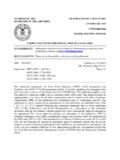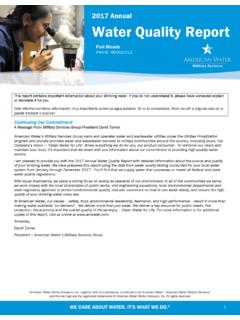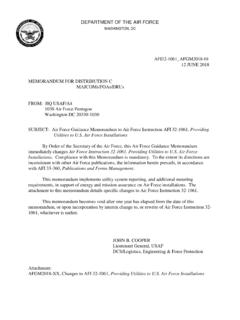Transcription of Acts that regulate water directly administrated by …
1 Fact Sheet: What is the provincial legal structure around water in Ontario? There are three bodies that regulate Ontario s water supply: the Ontario Ministry of the Environment, the Ontario Ministry of Natural Resources, and the federal government. This factsheet deals with provincial legislation that protects drinking water in Ontario. Acts that regulate water directly administrated by Ontario s MOE Ontario water Resources Act (1990) The Ontario water Resources Act is the most important law governing water quality and quantity in the province. It is a general water management statute whose origins date back to the 1950s. It applies to both groundwater and surface water . Administered by the Ministry of the Environment, the Ontario water Resources Act contains a number of important mechanisms that protect water resources.
2 The Ontario water Resources Act: Prohibits the discharge of polluting material in or near water (section 30); Prohibits or regulates the discharge of sewage (section 31); Enables the issuance of orders requiring measures to prevent, reduce or alleviate impairment of water quality (section 32); Enables the designation and protection of sources of public water supply (section 33); regulates water takings in excess of 50,000 litres a day (section 34); regulates well drilling and construction (sections 36 to 50); Requires approvals for water works (section 52); Requires approvals for sewage works (section 53); Enables the Ontario Clean water Agency to provide or operate water works or sewage works for municipalities (sections 63 to 73); Designates and regulates areas of public water or sewage services (section 74); Imposes a duty on corporate officers and directors to take all reasonable care to prevent the corporation from discharging materials into or near water that may impair water quality (section 116); In addition, regulations under the Ontario water Resources Act have been enacted on a variety of water -related matters.
3 These include: water taking and transfers ( 285/99); Exempting minor watermain, sewer or stormwater management projects from approval requirements ( 525/98); Classifying water works and sewage works, licensing of facility operators and operating standards ( 435/93); Licensing of well contractors and technicians and requirements for well construction, operation and abandonment (Regulation 903); and Contraventions by secured creditors, receivers and trustees in bankruptcy ( ). For more information on water taking (O. Reg. 285/99) in Ontario, see the water Taking FAQ. The Ontario water Resources Act makes it an offence to contravene either the Act, regulations, orders, licenses, permits or approvals under the Act (section 107). Various penalties -- fines, jail terms, profit-stripping, restitution, restoration orders, forfeiture or license suspension -- may be imposed against individuals or corporations convicted under the Act (sections 108 to 112).
4 In addition to prosecution, administrative penalties may be available (section ). Environmental Protection Act (1990) The Environmental Protection Act is the principal pollution control statute in Ontario. It is used interchangeably with the Ontario water Resources Act to address sources of water pollution. The Act contains a number of general provisions that can be used to protect surface water and groundwater against contamination. The Environmental Protection Act: Prohibits discharges of contaminants into the natural environment in an amount, concentration or level in excess of prescribed regulatory standards (section 6); Authorizes the issuance of binding administrative orders to prevent, control, minimize or remediate discharges of contaminants into the natural environment (sections 7 to 12, sections 17 to 18, section 97, Part XI and Part XIV); Prohibits the discharge of contaminants into the natural environment that cause or are likely to cause an adverse effect (section 14); regulates the approval, construction, operation and closure of waste disposal sites and waste management systems (Part V).
5 Imposes duties to report and clean up pollutant spills and imposes civil liability for loss or damage arising from spills (Part X); Authorizes conditions of approval (including permits and approvals under the Ontario water Resources Act) which require proponents to provide financial assurance to secure performance of environmental protection measures (Part XII); Imposes a duty on corporate officers and directors to take all reasonable care to prevent the corporation from causing or permitting unlawful discharges of contaminants into the natural environment (section 194). In addition, the Environmental Protection Act creates broad regulation-making authority on a long list of environmental matters (sections to 177). This authority has been used to enact water -related regulations such as: Deep Well Disposal (Regulation 341), Discharge of Sewage from Pleasure Boats (Regulation 343), Marina Facilities (Regulation 351), Sewage Systems (Regulations 358 and 359).
6 The Ministry of the Environment has also used the Environmental Protection Act, rather than the Ontario water Resources Act, to enact regulations for limiting discharges into waterways from different industrial sectors. Under the Municipal Industrial Strategy for Abatement (MISA) program, regulations have been set to control pollution from the petroleum industry in Ontario, the pulp and paper industry, metal mining, industrial metals, metal casting, organic chemical and manufacturing, inorganic chemical industry, iron and steel manufacturing industry and the electrical power generating industry. The Environmental Protection Act makes it an offence to contravene either the Act, regulations, orders, licenses, permits or approvals under the Act (section 186).
7 Various penalties fines, jail terms, profit stripping, restitution, remedial orders, forfeiture or license suspension may be imposed against individuals or corporations upon conviction under the Environmental Protection Act (sections 187 to 193). Administrative penalties may also be available (section ). Environmental Assessment Act (1990) The Environmental Assessment Act is Ontario's primary environmental planning statute. The general rule is that public sector undertakings (such as provincial or municipal projects) are caught by the Environmental Assessment Act unless exempted. Conversely, private sector undertakings are not caught by the Environmental Assessment Act unless they are specifically designated by regulations as undertakings to which the Act applies.
8 For example, private proposals to establish or expand waste disposal sites are typically designated under the Act. If caught by the Act, proponents are generally required to identify and evaluate ecological, social, cultural and economic impacts that may be caused by the undertaking and its alternatives. Such undertakings cannot proceed unless the proponent completes the required environmental assessment with agency and public input, and receives approval to proceed from the Minister of the Environment. The Minister may reject environmentally unsound undertakings, or may approve environmentally sound undertakings, subject to terms and conditions that prevent, reduce or mitigate adverse environmental effects. The Minister also has the power to refer the matter, in whole or in part, to the Environmental Review Tribunal for public hearings.
9 In addition, the Ministry of the Environment has used the Environmental Assessment Act to approve "Class Environmental Assessments", which prescribe streamlined planning procedures for certain defined classes of projects. Unlike the individual environmental assessment process, the proponent of a class environmental assessment project follows the prescribed planning process without the need for project-specific approval from the Minister of the Environment or the Environmental Review Tribunal. Most class environmental assessments, however, include "bump up" provisions that allow the Minister to order proponents to carry out an individual assessment of particularly significant or controversial projects. The Minister of the Environment has approved a class environmental assessment process for municipal road, water , and sewage and stormwater projects.
10 For water projects, the purpose of the municipal class environmental assessment is to ensure that projects will be "undertaken to address problems affecting the operation and efficiency of existing water systems, to accommodate future growth of communities, or to address water source contamination problems." Municipal water and Sewage Transfer Act (1997) Transferred ownership of some 230 provincially-owned water and wastewater plants from OCWA to municipalities. With the transfer, virtually all water and wastewater systems in Ontario are now owned and controlled by the municipality in which they are situated. At the time of the transfer, many municipalities chose to continue to use OCWA for operations. Safe Drinking water Act (2002) The purpose of the Safe Drinking water Act is to protect human health through the control and regulation of drinking water systems and drinking water testing.



